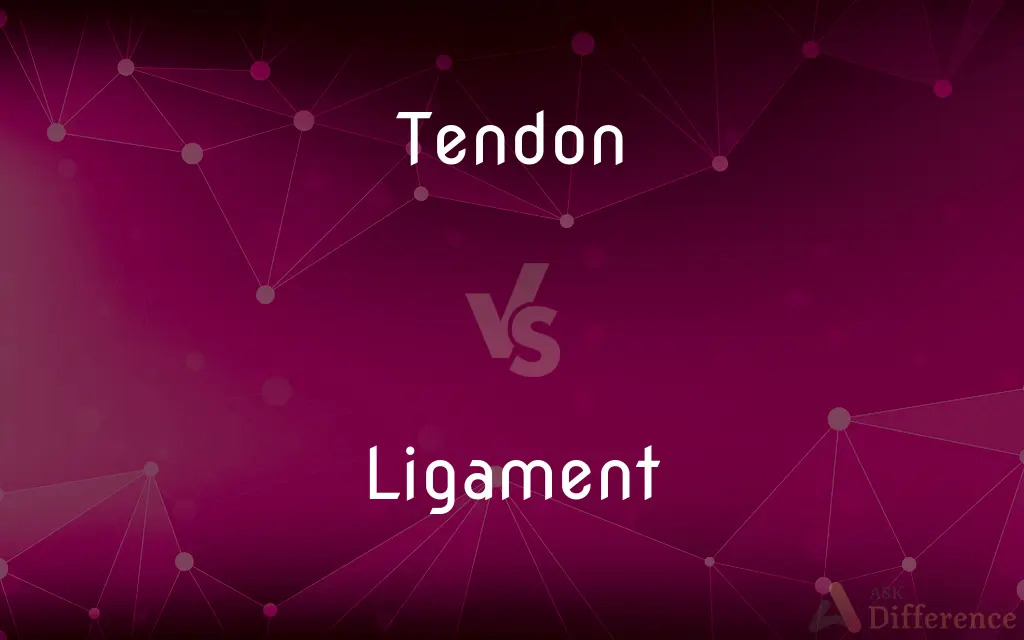Tendon vs. Ligament — What's the Difference?
Edited by Tayyaba Rehman — By Fiza Rafique — Updated on November 1, 2023
Tendons connect muscles to bones, facilitating movement, while ligaments connect bones to bones, stabilizing joints.

Difference Between Tendon and Ligament
Table of Contents
ADVERTISEMENT
Key Differences
Tendons are strong, flexible bands of fibrous tissue that attach muscles to bones, enabling the bones to move when muscles contract. Ligaments, on the other hand, are also made of fibrous tissue but connect bones to other bones at joints, providing stability and guiding motion.
While tendons are designed to withstand tension and provide the force for movement, ligaments are designed to resist strains and prevent unwanted movement, protecting joints from damage. Tendons are generally more flexible than ligaments, which are taut and limit the range of motion for the protection of the joint.
Injuries to tendons, such as strains and tendinitis, usually occur because of repetitive movements or overuse. Ligament injuries, like sprains, often result from overstretching or tearing due to sudden movements or impacts.
Both tendons and ligaments have limited blood supply; therefore, they take longer to heal compared to muscles and other tissues with better blood flow. Rehabilitation from injuries to either tendons or ligaments often requires rest, physical therapy, and sometimes surgery.
The repair process for both tendons and ligaments involves inflammation, collagen deposition, and gradual tissue remodeling, but due to their different functions, the approach to treating injuries in tendons and ligaments can vary significantly.
ADVERTISEMENT
Comparison Chart
Connects
Muscle to bone.
Bone to bone.
Function
Facilitates movement.
Provides stability to joints.
Flexibility
More flexible, allows movement.
Less flexible, restricts movement.
Injury Type
Strains and tendinitis.
Sprains and tears.
Healing Time
Slow due to poor blood supply.
Slow, similar to tendons.
Compare with Definitions
Tendon
A collagenous fibrous tissue connecting muscle to bone.
The Achilles tendon is critical for walking.
Ligament
Ligaments support and strengthen joints.
Ligaments around the ankle prevent excessive movement.
Tendon
Tendons transmit the force of muscle contractions.
Her bicep tendon flexed with the lift.
Ligament
Structurally ligaments are made of crisscross fibers.
The ligament's crisscross pattern provides joint stability.
Tendon
Tendons can be stretched or torn in injury.
The MRI showed a torn rotator cuff tendon.
Ligament
Ligaments can be sprained or torn when overstretched.
He suffered a ligament sprain while playing soccer.
Tendon
Tendons are crucial for locomotion.
Every step involves the tendon of the leg muscles.
Ligament
Ligaments help in maintaining proper alignment of bones.
The spinal ligaments maintain vertebral alignment.
Tendon
A tendon or sinew is a tough high-tensile-strength band of dense fibrous connective tissue that connects muscle to bone and is capable of withstanding tension and transmit the mechanical forces of muscle contraction to the skeletal system. Tendons are similar to ligaments; both are made of collagen.
Ligament
A ligament is the fibrous connective tissue that connects bones to other bones. It is also known as articular ligament, articular larua, fibrous ligament, or true ligament.
Tendon
A band of tough, inelastic fibrous tissue that connects a muscle with its bony attachment.
Ligament
(Anatomy) A sheet or band of tough, fibrous tissue connecting bones or cartilages at a joint or supporting an organ.
Tendon
(anatomy) A tough band of flexible but inelastic fibrous collagen tissue that connects a muscle with its bony attachment and transmits the force which the muscle exerts.
Ligament
A unifying or connecting tie or bond.
Tendon
(biology) The hamstring of a quadruped.
Ligament
(anatomy) A band of strong tissue that connects bones to other bones.
Tendon
(construction) A wire or bar used to strengthen prestressed concrete.
Ligament
(figurative) That which binds or acts as a ligament.
Tendon
A tough insensible cord, bundle, or band of fibrous connective tissue uniting a muscle with some other part; a sinew.
Ligament
Anything that ties or unites one thing or part to another; a bandage; a bond.
Interwoven is the love of liberty with every ligament of your hearts.
Tendon
A cord or band of inelastic tissue connecting a muscle with its bony attachment
Ligament
A tough band or plate of dense, fibrous, connective tissue or fibrocartilage serving to unite bones or form joints.
Tendon
Structurally tendons are made up of parallel fibers.
Tendon fibers align with the direction of force.
Ligament
A sheet or band of tough fibrous tissue connecting bones or cartilages or supporting muscles or organs
Ligament
Any connection or unifying bond
Ligament
A band of tissue connecting bones across a joint.
The anterior cruciate ligament stabilizes the knee.
Common Curiosities
What is a ligament?
A ligament is a fibrous connective tissue that connects bones to other bones at a joint.
What are common injuries to tendons and ligaments?
Tendons often suffer from strains and tendinitis, while ligaments can have sprains and tears.
What makes ligaments less flexible than tendons?
Ligaments are less flexible to restrict excessive movement and stabilize joints.
Why do tendon and ligament injuries heal slowly?
They have limited blood supply, reducing the nutrients and oxygen necessary for healing.
How can tendon and ligament injuries be treated?
Treatments include rest, physical therapy, bracing, and sometimes surgery.
What is a tendon?
A tendon is a fibrous connective tissue that attaches muscle to bone.
How do tendons and ligaments differ in function?
Tendons help in movement by transmitting force from muscle to bone, while ligaments provide joint stability.
What role do ligaments play in sports?
Ligaments provide joint stability essential for safe and effective movement in sports.
Can tendons and ligaments stretch?
Both can stretch slightly but are prone to injury if overstretched.
What's the difference between tendinitis and sprains?
Tendinitis is inflammation of a tendon, while a sprain is an injury to a ligament.
What role do tendons play in locomotion?
Tendons transmit the force of muscle contractions to bones, causing movement.
Do tendons or ligaments have a higher tensile strength?
Tendons generally have higher tensile strength to deal with the force of muscle contractions.
Are tendons or ligaments more elastic?
Tendons are more elastic to facilitate movement.
Can tendons and ligaments regenerate?
They can heal, but their regenerative capacity is limited compared to other tissues.
Is a torn tendon or ligament more serious?
It depends on the severity, but both can be serious and potentially require surgery.
Share Your Discovery

Previous Comparison
Costing vs. Budgeting
Next Comparison
Matrix vs. SpreadsheetAuthor Spotlight
Written by
Fiza RafiqueFiza Rafique is a skilled content writer at AskDifference.com, where she meticulously refines and enhances written pieces. Drawing from her vast editorial expertise, Fiza ensures clarity, accuracy, and precision in every article. Passionate about language, she continually seeks to elevate the quality of content for readers worldwide.
Edited by
Tayyaba RehmanTayyaba Rehman is a distinguished writer, currently serving as a primary contributor to askdifference.com. As a researcher in semantics and etymology, Tayyaba's passion for the complexity of languages and their distinctions has found a perfect home on the platform. Tayyaba delves into the intricacies of language, distinguishing between commonly confused words and phrases, thereby providing clarity for readers worldwide.















































